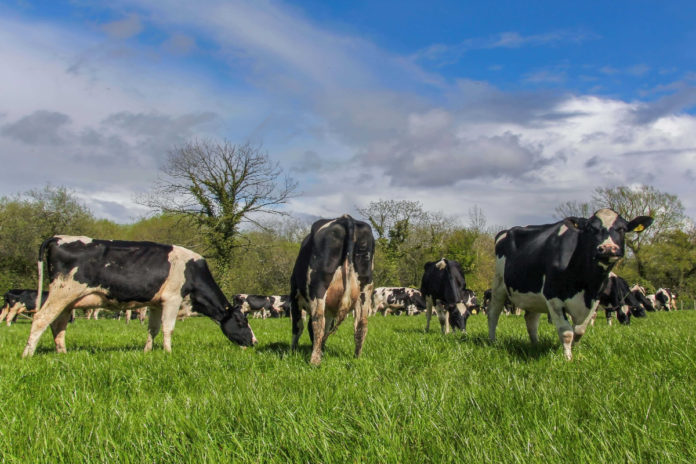In recent years, there appear to have been more and more cows being housed over the summer months.
In some cases, this may have been as a result of herds having outgrown the available grazing area, while in others it may simply have been that grass and grazing has been seen as being too variable, complicated and perhaps unfashionable.
Opportunity
Michael Verner, a Dairying Development Adviser based at the College of Agriculture, Food and Rural Enterprise (CAFRE) said: “This summer presents us all with an opportunity to get back to basics, graze cows well and drive down our costs of production.”
“Many herds are now out full-time and typical performance is that daily milk yield (litres/cow/per day) is 27.8, feed rate (kg/per litre) is 0.2, meal feed (kg/cow/per day) is 5.6 whilst the milk from forage yield (litres/cow/per day) is 15.5.”
“The figures for rolling performance of herds show that the annual milk yield (litres/cow/per year) is 7,974 and the feed rate (kg/litre) is 0.26. This comes from a meal feed (tonnes/cow/per year) of 2.07 and milk from forage (litres/cow/per year) is 3,360.”
“Many factors have to be considered when grazing cows but two of the biggest challenges involve. These are achieving the highest possible grazing intakes while at the same time maintaining grass quality throughout the grazing season and setting realistic performance levels (M+) that can be achieved before concentrate supplementation.”
The aim should be to offer cows upright, dense, palatable swards of grass on a consistent basis. You will be constantly balancing grazing pressure and sward growth throughout the grazing season.
Grassland management
Michael Verner added: “Ideally you will be turning cows into pre-grazing covers of 3,000 – 3,200kg DM/ha to maximise intake/bite and be taking cows out at covers of 1,800kg DM/ha (6-8cm).”
“If cows are offered this grass then intakes of 16-17kg DM/head/day can be achieved and this has the potential to support milk levels of 20 litres. To ensure cows are allocated the correct amount of grass each day, walking and measuring grass covers on the grazing area on a weekly basis is very important.”
“This enables any grass surplus or shortfall to be identified and action to be taken in a timely manner. As a rule of thumb a herd of 120 cows will require between 3 and 3.5 acres per day. Not only is grass quality and intake important, so too is water availability.”
“Generally a cow requires five litres of water for every litre of milk produced with approximately half of the herd’s daily water requirement being consumed after each milking, so it is important to provide adequate trough capacity and water flow rates to meet your herd’s demand.”
Intake
In order to supplement your cows accurately you not only need to know how much grass they are eating on a daily basis, but you also need to assess the quality of the grass they are getting.
Sometimes both grass intakes and quality are overestimated, with the result that cows are underfed concentrates, leading to a drop in milk yield and, if left unchecked, body condition.
Michael said: “Very often grass will be blamed. In the South Down area for example, grassland farmers are saying that grass today is capable of maintaining the cow and producing at least 18 litres of milk (some will aim higher) and are supplementing cows at a feed rate of 0.45kg/litre for every litre over this.
“Most will be expecting that heifers will produce two-three litres less from grass than mature cows. These levels of performance assume both good grass intakes and quality. As the season progresses and grass quality declines these M+ figures will be scaled back.”
“Maybe you think this all sounds like a lot of hard work when you could simply keep them in the house on a consistent diet with every day being the same.”
“What about the cost? In the current climate can you afford not to be making use of the best quality feed on your farm which also is the cheapest forage on your farm?”
“A herd of 120 cows at grass full-time, could possibly be saving £120-£140 per day in diet costs compared to a similarly sized housed herd. The question is, can you afford to miss this opportunity in this current difficult time?”





